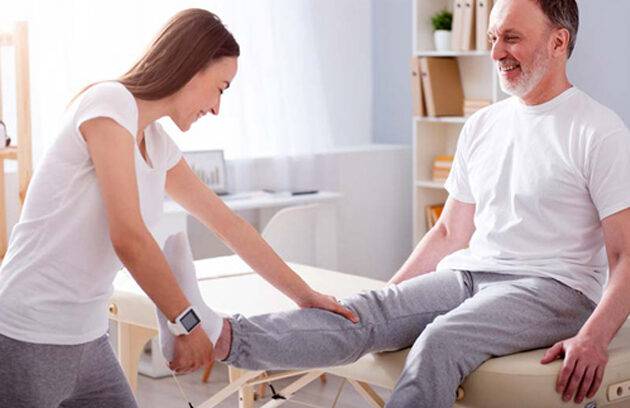Overview
Hemiparesis is a weakness that occurs on one side of the body due to the secondary effect of the injury to the Central Nervous System. The treatment for the same involves engaging the Central Nervous System to heal in itself naturally. Inorder to reach this process physiotherapy is done to generate, rearrange and strengthen the neural pathways.
What leads to
hemiparesis?
Hemiparesis is most usually caused by a stroke, in which the blood flow to the brain is interrupted, resulting in the death of brain cells. Due to this process, the brain areas that are responsible for the movement get affected thus resulting in the condition—of hemiparesis (weakness on one side of the body or hemiplegia( paralysis on one side of the body). The movement of the body is controlled by each part of the hemisphere of the brain. Therefore, hemiparesis typically affects the side of the body opposite to the side of the stroke, whereas some strokes or brain injuries can lead to the weakening of the muscles on the same side as the injury which is known as ipsilateral hemiparesis. The motor cortex is not the only part of the brain that controls movement; other parts of the brain, such as the cerebellum, also play a role. As a result, there's a higher chance of a stroke or a brain injury affecting a movement-related section of the brain. Cerebral palsy, brain injury, and other disorders that impact the nervous system or brain, such as malignancies or tumours, can all induce hemiparesis. These conditions are less common, although they are still present.
Symptoms of hemiparesis range from minor weakness to a severe one on one side of the body.
- difficulty in standing
- difficulty
in walking
- strange
sensations on the body's affected side
- Overcompensation causes strain
on the unaffected side of the body
How can hemiparesis be cured through physiotherapy?
Physiotherapy is the best
way to cure hemiparesis by rehabilitating the nervous system. Neuroplasticity
is not a matter of overnight. It needs frequent training and a rehabilitation
programme to keep the recovery running for a long time. Physiotherapy helps in
regaining optimal functioning. Physiotherapists have designed exercises
for patients with hemiparesis to target and cure the affected limbs.
Physiotherapy helps in
retraining the affected limbs through repetitive exercises. The more an
individual moves his affected side, the higher neuroplasticity occurs in
response to it. In terms of consequences the individual gains liberty in doing
the daily activities like eating, dressing, bathing, etc. Apart from this
functional training is also given which includes lifting a spoon, holding any
something and then again keeping it back.
Individuals can learn compensation techniques and navigate their new life with the help of shortcuts. Doing regular exercise will help the individual in maximizing the chance of motor recovery.
Repetitive Practice
Neuroplasticity is a result of repetition and consistency. It is critical to engage neuroplasticity by repeating skilful motions with the weakest side. As you will do more work, you will be better at recovery. This is known as massed practice, and it is necessary for hemiparesis rehabilitation.
Home Exercise Programs
Home fitness programmes are significant because they can help people
improve by allowing them to practise exercises in a group setting at home.
Physiotherapists recommend completing home exercise programmes to build upon the abilities obtained in physiotherapy sessions, depending on the frequency of the appointments. It is critical to continue practising outside of therapy sessions in order to maximize neuroplasticity and functional recovery.
Constraint-Induced Movement Therapy
Constraint-Induced Movement Therapy (CIMT) is a treatment in which the unaffected side is restrained while the affected side is exercised for 10-15 consecutive weekdays, each day for several hours. CIMT is most typically utilized for affected arms and hands, although it can also be used for damaged lower extremities. It demonstrates remarkable improvement because it is a more aggressive therapy in terms of volume.
Mirror Therapy
A mirror is put over the hemiparetic arm or leg in this therapy. The individual next performs exercises with the stronger arm or leg while looking in the mirror at the moving image. The brain is tricked into thinking both arms or legs are moving by this image in the mirror, which helps to stimulate neuroplasticity.
Electrical Stimulation
Electrical stimulations are delivered to the muscles via pads on the skin, stimulating movement in the weaker muscles. If a person has a weak hand or wrist movement, for example, the physiotherapist can use electrical stimulation to help flex and extend the wrist depending on the placement. These simulations can be paired with task-related training for the best effects.
Mental Practice
Mental practice is a cognitive technique that can activate neuroplasticity without requiring any action. It entails mentally rehearsing specific activities in order to improve their performance. Hemiparesis patients are instructed to spend time mentally rehearsing their activities before doing them.
There is no set time for recovery, and predicting neurological recovery time can be difficult because each person’s brain is wired differently. Hence, making healing after each neurological injury unique. Think Physiotherapy, being the best physiotherapy clinic in Surrey with expertised physiotherapists who can provide you with the best consulting and treatment of hemiparesis as well.









No comments:
Post a Comment